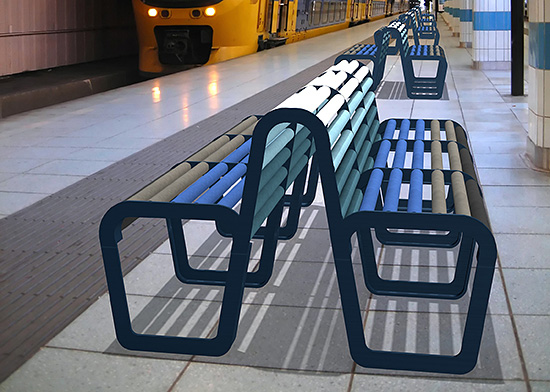Ceramic Tile: Solutions for Holistic Sustainability
Yet there are other, hidden benefits for some product types—including ceramic tile, masonry, wood and others—that have longstanding reputations as healthy, durable materials. In the case of tile, these baseline attributes include zero VOC content, which improves the major LEED category of indoor environmental quality (IEQ) and without any third-party verifications automatically increases the portion of building materials qualified as low-emitting products. Another area for consideration is mechanical durability, and tile resists degradation caused by use such as foot traffic (mechanical wear) as well as chemical reactions, ingestion by living organisms, and erosion due to wind or water.
There are other considerations. Ceramic tile is unaffected by ultraviolet (UV) light, for example, which fades and prematurely stresses some finishes. It is nonflammable and resists water damage, giving it resiliency—a beneficial effect that accrues to entire flooring or wall cladding assemblies as well. As part of a given building assembly, it adds thermal mass and a relatively valuable barrier layer or rainscreen for compatible construction types.
In this way, ceramic tile demonstrates the possibility of holistic material selection to address integrated sustainable design challenges. This premise has been developed by leading sustainability thinkers such as Anton Schneider, Ph.D., founding director of the Institute of Building Biology + Sustainability based near Munich. According to Schneider, “building biologists” should evaluate construction materials based foremost on four properties: Ecological compatibility; diffusion/breathing properties; toxic vapors and gases; and electrical properties and radioactivity. Secondarily, Schneider encourages designers to look for advantages in:
- Natural occurrence
- Energy consumption
- Thermal properties
- Acoustic properties
- Hygroscopicity (ability to absorb or release water as a function of humidity)
- Health impact
- Overall impression (including both aesthetic benefits and application opportunities)
On top of this short-listing, Schneider’s baubiologie is based on 25 varied principles that contribute to a holistic understanding of sustainability, such as reducing human-made disturbance, social burdens and environmental problems while providing for low moisture content, a neutral smell, good ergonomics, and personalized, natural, human-oriented solutions.
It’s hard to argue with those qualities—yet a surprising number of common building materials and systems not only violate such rigorous criteria but they even limit the availability of some LEED credits. For a holistic, integrated approach to green building, savvy architects are looking for products that are more like living plants than industrial products.
Occupant Health and Tile Applications
When considering how best to achieve sustainable outcomes, it is important to think of the users—people, in other words—as an integral part of the environment. This conception of sustainability as encompassing human experience has been called the “blue component of green design,” referring to the term blue design coined by Bob Isherwood, an advertising executive with the firm Saatchi & Saatchi, during a presentation at the 2008 Sustainable Brands Conference. Further refined by the Spanish design firm Fenwick Iribarren Architects, blue design has come to refer to a third stage of a tripartite historical development of architecture as it relates to the natural environment:
1. In the first, or “Black” stage, the focus was on people with little concern for impact on the natural environment.
2. The second, or “Early Green” stage, the emphasis switched completely to the natural environment, energy efficiency, pollution control and the like, but with relatively little interest in how people related to the buildings and spaces.
3. The third, or “Blue” stage represents a balance: Rather than focusing on what is sustainable for people or what is sustainable for the natural environment, blue design describes “sustainability for people within the natural environment.”
In other words, the term sustainability now refers not only to how a structure impacts the natural environment, but how it impacts the people who use it.
One area where this people-environment duality is manifest comes from the growing concerns regarding occupant health and safety. Beginning during early audits of the first LEED-certified buildings starting in 2001, the importance of factors like daylight and fresh air moved to the foreground of design considerations. As LEED took hold, other key side benefits revealed themselves, too: Productivity was increasing, as was occupant “health and happiness,” as documented by LEED projects owners such as Tingyue Wang of Jiaming Investment in Beijing, chronicled in a recent article published by the U.S. Green Building Council. Savvy architects maintain that truly sustainable development is subject to validation by users and owners, as much as by impact on the natural environment.
Photo courtesy of Washington State University
Without VOCs and known for its durability and other environmental benefits, ceramic tile has also gained appreciation among designers looking for ways to improve end-user health and happiness, as at this subway stop with its ceramic tile benches and finishes.









